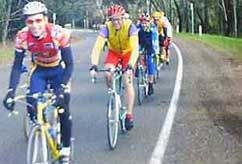<ALIGN=CENTER>
|
<ALIGN=CENTER>How To Ride In A Group By Fred Matheny |

Pacelines you see in pro racing are organized. They have specific rules. But in big groups like you find in centuries or charity rides, things will be disorganized. This can intimidate even experienced riders.
Sooner or later you’ll find yourself in a big group amid some riders with sketchy skills. It pays to learn how to survive (and also make yourself welcome) in a crowd.
-
Look for Risky Riders. These are the unsteady people who wobble, appear nervous, have a tense grip on the handlebar, and frequently grab the brakes. Avoid them! Move up to keep them behind you, or slide to the other side of the road.
-
Stay at the Front. This is easy to say but hard to do in some groups. At the front you have more control over your destiny because most crashes occur in the rear two-thirds of the bunch. It may take a bit more work to reach the front and stay there, but it’s worth the effort.
-
Watch the Wind. Wind direction determines on which side the greatest draft is found. If the wind is from the right side of the road, smart riders move to the left of the wheel in front of them for greater protection. If you’re doing this, beware of overlapping wheels with inexperienced riders. They may swerve and take out your front wheel.
-
Be Wary on Climbs. A major cause of group crashes is riders who stand abruptly. They slow for a second, causing the rider behind to hit their rear wheel and spill. To avoid this danger, let the gap open a bit on hills or ride a foot to either side. To avoid being the one who causes such a crash, pull your bike forward as you leave the saddle. Don’t lunge and make a hard pedal stroke. Keep your speed steady. When sitting again, push the bike forward a bit.
Practice Safety Skills
Cycling isn’t a contact sport, but it’s not uncommon to have your arm brushed when riding near others in a group. It pays to learn how to bump into other riders without swerving or falling. It’s easy when you practice this drill used at the Carpenter-Phinney Bike Camps.
First, go with a cycling friend to a large grassy area like a soccer field. Ride side-by-side at a walking pace. Keep both hands on your bar. Start by gently touching elbows, then shoulders. As you gain confidence, lean more vigorously on the other rider. Soon, you’ll be bumping each other with abandon and throwing in a few head butts for fun, all without going down. (Of course, always wear your helmet just in case.)
Riding relaxed is the key to absorbing contact without swerving. Have slightly bent elbows, a firm-not-tight grip on the bar, and loose arm and shoulder muscles. If you’re relaxed, your body can absorb the shock before it gets to the handlebar.
 This article is provided courtesy of RoadBikeRider.com and was written by its co-founder Fred Matheny (left). Fred was the Training and Fitness Editor of Bicycling Magazine for a decade, has written many books on cycling including Fred Matheny's Complete Book Of Road Bike Training; and is a world-record-holding roadie.
This article is provided courtesy of RoadBikeRider.com and was written by its co-founder Fred Matheny (left). Fred was the Training and Fitness Editor of Bicycling Magazine for a decade, has written many books on cycling including Fred Matheny's Complete Book Of Road Bike Training; and is a world-record-holding roadie.
RoadBikeRider offers cycling books, many more cycling guides and even a free weekly e-mail newsletter full of tips and news for aspiring bicyclists. Receive a FREE copy of the eBook “29 Pro Cycling Secrets for Roadies” by subscribing today.
